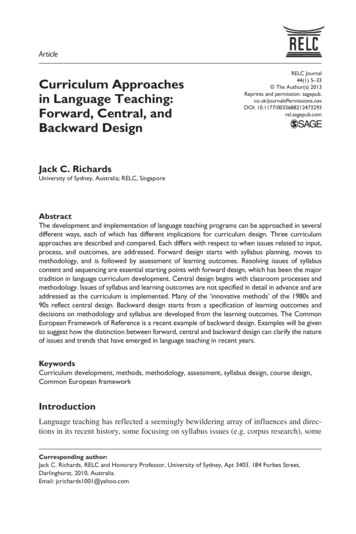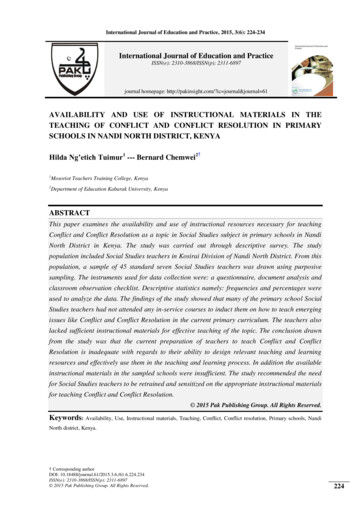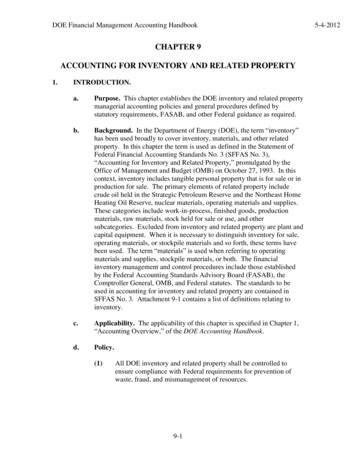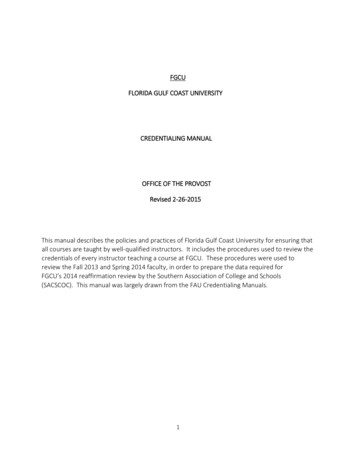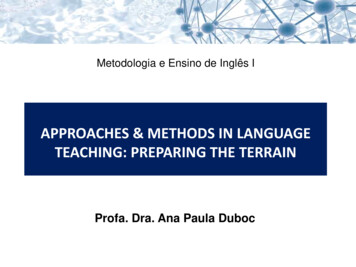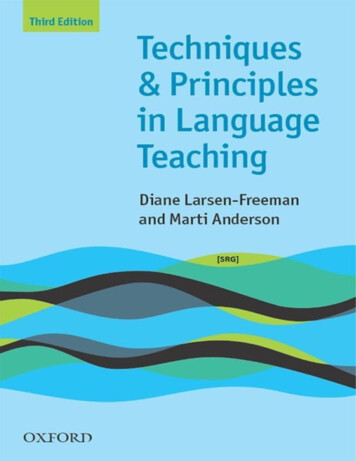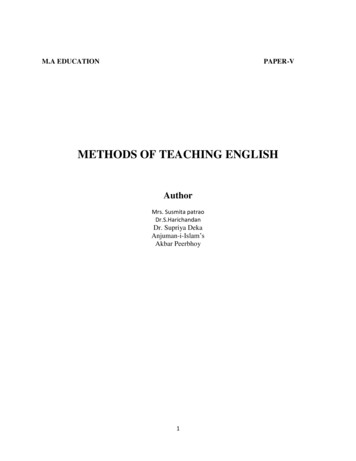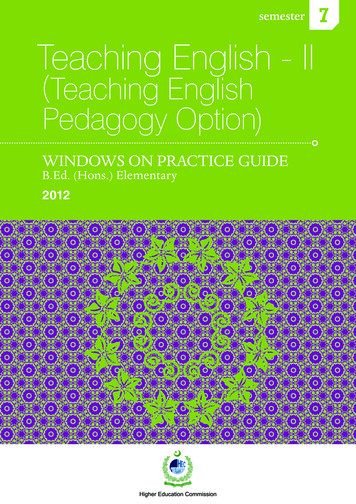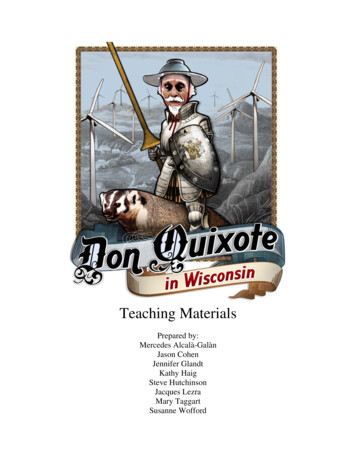
Transcription
Teaching MaterialsPrepared by:Mercedes Alcalà-GalànJason CohenJennifer GlandtKathy HaigSteve HutchinsonJacques LezraMary TaggartSusanne Wofford
Table of ContentsBackground Information for Teachers3Study Guide Questions11Study Guide Questions—Proposed Answers21Journal Assignments29Journal Assignments—Proposed Answers35Essay/Project Assignments39Essay/Project Assignments—ProposedAnswers49Tests and Quizzes53Supplementary Materials77Teaching Materials in Spanish79
2
Background Informationfor Teachers3
4
Chivalric themes and motifs1Whereas Cervantes’ first readers came to Don Quixote knowing about books of chivalry,modern readers generally read the other way around: we start with Don Quixote and becomefamiliar with certain aspects of the books of chivalry by way of Cervantes’ parody of them. Here,then, are some of the chivalric themes and motifs parodied in Don Quixote. The list is by nomeans complete, but should provide a good start.Although the parody of chivalric motifs extends throughout Don Quixote, the relationshipbetween Don Quixote and the books of chivalry isn’t always parodic. What’s more, while theparody of chivalric themes and motifs is especially intense in the first fifth of the novel (part I,chapters 1-10 and 15-22), there are long stretches where it’s absent or nearly absent. OnceSancho really becomes Sancho (as of part I, chapter 20, let’s say), and the stories of othercharacters work their way into the novel, other principles besides the parody of chivalry organizethe ways the novel develops.1. the wise chronicler (el sabio cronista) and the found manuscriptThe books of chivalry generally pretend to be translations of old books written by wisemen (sabios) in foreign languages. The real author usually adopts the pose of a translator of thatoriginal text. These old manuscripts tend to be found quite by chance, in strange circumstances.There is at least one case in which the “original text” was supposed to have been written inArabic (and found in Tunisia, North Africa).In I,2, Don Quixote assumes that his story will likewise be written by such a sabio, andeven goes so far as to imagine the flowery language in which that text will begin. As long asthere’s a sabio who simply knows everything (who knows how?), there’s no need for anyone towitness what Don Quixote does. In I,9 Cervantes takes the game a quantum leap further with thefinding of Cide Hamete Benengeli’s text in Arabic. However (apart from this wonderfulchapter), only in the second part of Don Quixote does Cervantes really exploit the novelisticpossibilities of this text written in Arabic by a Moor.2. chivalric time and spaceChivalric action happens in its own space where certain types of places are especiallyimportant, e.g., openings in the forest, crossroads, castles, caves. As far as time goes, the dawnacquires a mythical aura, and most chivalric events take place in spring and summer.Don Quixote obviously looks for these kinds of places and transforms inns into castles.The cave becomes important in the second part of the novel. There are various flowerydescriptions of the dawn in Don Quixote (parodying the style of books of chivalry). And DonQuixote’s calendar is all messed up because it starts in July, and months later (in the second partof the novel), we’re still in July of the same year (of 1614! i.e., 9 years after the first part waspublished!). Cervantes knew the calendar as well as anyone, but he organizes Don Quixotemainly according to chivalric time, saints’ feasts, holidays, and so on. It’s always the middle ofsummer in Don Quixote.3. knighting1This summary is partly indebted to a study by Mari Carmen Marín Pina.5
This authorizes the knight to do all the kinds of activities a knight is supposed to do.Without it he’s impotent. Among other things, the ceremony consists of going to the chapel andwatching over the weapons he’ll be using. The ceremony is administered by a knight, usually animportant one, who strikes the novice with the flat side of the sword and utters appropriatewords. A damsel often girds the novices sword. It’s assumed that the knight performing theceremony will transfer his best qualities to the novice.When he ventures forth the first time (chapter 2), Don Quixote suddently realizes that hemust be knighted as soon as possible, and this gives way to the hilarious parody in chapter 3where the roguish inn-keeper performs a mock ceremony, and a prostitute girds Don Quixote’ssword.4. defending those in needThe knight errant is expected to defend his faith and his earthly rulers, and mete outjustice. Those in need tend to be damsels, widows and other women, orphans, and the poor. Inperforming these roles, the good knight has to confront bad knights, giants, monsters, etc. Onesuch motif in books of chivalry is the defense of squires being unfairly whipped.In chapter 4 Don Quixote performs such an act of justice by “defending” Andrés. Andfrom the very beginning this ethic of dispensing justice in the world motivates Don Quixote.5. challenges and duels for his ladyA knight who isn’t in love is nobody. His lady endows him with purpose, strength andvalor. Love obliges him to increase his fame and to take on adventures, duels, jousting, etc.Knights generally fight about whose lady is more “beautiful”, and whoever wins proves hisargument.This motif is present in many passages, e.g, chapters 1, 4.6. loveThe knight and the lady: their love is plagued with obstacles, including extendedabsences (sometimes alleviated by letters, gifts, etc.) and sometimes jealousy. When therelationship is in danger of breaking up, the knight becomes depressed and usually suspends hisknightly activities in some secluded place.Don Quixote invents his own kind of penitence in chapters 25-26, suffering for Dulcineain the wilderness of the Sierra Morena, but without her having given any cause for this suffering.7. courtingThe knight is supposed to remain faithful to his lady and reject the love of other women.In his wanderings the knight involuntarily enamors ladies with his looks, character and fame.These ladies may include queens, princesses, wandering damsels, widows, etc. Unless he’sunfaithful, the knight excuses himself by declaring his love for his lady. Sometimes women fakebeing in love with knights and make fun of them.Don Quixote finds himself in situations where he imagines that women are in love withhim, and he shields himself by invoking his love for Dulcinea (e.g., chapters 16-17).8. enchanters and magiciansThese enchanters change their own figure, predict the future, travel by magical means,and can either be friends or enemies of the knight, helping him or doing him harm.6
These too are often evoked by Don Quixote, e.g., when his library disappears in chapter7, or when he explains why adventures go wrong such as with the windmills in chapter 8.9. enchantmentsEnchanted characters undergo metamorphoses (changes, “mutations”, etc.): they can betransformed into statues or animals, they can be tortured or deprived of their freedom, they candeteriorate physically. Sometimes the lady may be enchanted. Means of transport such as horsesor boats can also be enchanted. In the case of people, the challenge lies in finding out how todisenchant them.The enchantment of Dulcinea affects much of the second part of Don Quixote.10. the squireA knight such as Amadís de Gaula (Don Quixote’s main model) wanders aboutaccompanied by a squire who performs a variety of tasks, among them that of courier betweenknight and lady.Sancho Panza starts out as a sort of squirely apprentice, but soon takes his role far beyondanything scripted in the books of chivalry.11. the horseThe knight’s horse takes on a personality all its own, and often has a name. Since theknight errant wanders, the horse typically decides the route.In chapter 1, Don Quixote gives a name to his horse before he names himself or his lady.Don Quixote frequently lets the scrawny Rocinante lead the way. There’s a special bond andsimilitude between the knight and his horse.12. the giantThese are not only physically but also morally monstrous. They steal maidens, takeprisoners, usurp kingdoms, have incestuous love affairs, etc.Don Quixote imagines many such giants, including Caraculiambro (which could betranslated as Big Face Ass) in chapter 1, or the windmills in chapter 8.13. warBesides waging his own battles, the knight is expected to take part in wars and help hisown side.Don Quixote takes sides in a battle he imagines in chapter 18, where the armies turn outto be flocks of sheep.14. invented adventures and practical jokesSometimes other characters invent nonexistent adventures and, for different reasons,convince the knight to undertake them.This happens many times to Don Quixote, e.g., with the princess Micomicona in the firstpart and in the household of the duke and duchess in the second part. It’s important to note thatthis doesn’t only happen in Cervantes novel but also in the books of chivalry.Prepared by Steve Hutchinson7
Don Quixote Narrative Structure, Narrative Voice, and the Nature ofRealityOne of the main questions that comes up in this book is what is real and true? Cervantes likes toplay around with reality vs. illusion and truth vs. fiction, and he makes choices in his narrativestructure and narrative voice, as well as in his characterizations of his main characters, thatprovoke much thought and some confusion about the nature of reality. In terms ofcharacterization, for example: Don Quixote is a fictional character in a fictional work, who isinspired by the books he reads (fictional accounts of chivalric heroes) to recreate himself as aknight errant and go forth on adventures. So we have a fictional character creating an identitydifferent from his real identity (in other words, a fiction) based on works of fiction that hebelieves are real and historical. And just because he’s not “really” a knight errant, that doesn’tkeep him from hiring a squire, devoting himself to a lady love, and encountering “real” battlesand adventures.Confused? Well, it gets worse—or better, depending on your point of view. The confusion thatthe character of Don Quixote has between reality and illusion is also reflected in Cervantes’choices for his narrative structure and voice. Information on Cervantes’ narrative structurebelow is from David L. Solomon’s English 202 website from the University of Maryland:“The narrative structure of Don Quixote is highly complex. At times, the reader feels unsurewhat is real and what has been invented by Cervantes. This is because the story is metafictive.It is a story within a story within a story within a story again. (The prefix "meta" is Greek for"again" meaning literally, "fiction again.")If anything, the narrative structure mirrors the complexities of the Don Quixote characterhimself. Just as Don Quixote blurs reality with imagination, Cervantes does the same.”One way that Cervantes blurs reality with imagination is in his narrative voice. Information onnarrative voice, below is taken partially from Abrams’ Glossary of Literary Terms:Aristotle’s Rhetoric, written in the 4th C BC, introduced the idea that when a public speakerperforms, the speaker creates a kind of narrator (a “voice”) who “expresses attitudes both towardthe characters and materials within the work and toward the audience to whom the work isaddressed,” who has, in other words, a particular point of view and is, to varying degrees,distinct from the actual person performing the speech. A speaker who wishes to persuade heraudience to support her must first persuade the audience that this narrator is trustworthy andcredible. The speaker must use a voice of authority. Writers also create a narrator who tells thestory in a distinct voice and from a particular point of view. In the case of Don Quixote,Cervantes writes the story from a first-person point of view. The narrator seems to be Cervanteshimself, since he refers to himself as “I,” but actually that narrator is a construction ofCervantes—a narrative voice. Like the audience for a speaker, the readers, in order to feelcomfortable that we are getting the “true story,” must trust that the narrator of the story iscredible. Cervantes, however, doesn’t want his readers to feel too comfortable—remember, helikes to play around with our perceptions of reality—so he makes choices in his narrative voicethat make us wonder whether or not what we are reading really happened—in the story or in real8
life. This idea will become clearer after we have read and discussed the prologue and the firstnine chapters. For now, just watch for shifts in the narrator’s point of view and try to be aware ofmoments when the narrator seems to step outside the story and talk to you directly. When younotice such moments, ask yourself what their effect is. What effect does changing the point ofview have on what you perceive as truth vs. fiction in the story? Does a direct address by thenarrator make you more or less trusting of the truth of his story?As we continue to read the novel, this issue of truth vs. fiction and reality vs. illusion will comeup again and again, on a whole bunch of different levels, and you will begin to recognize andappreciate the ways that Cervantes uses his narrative structure and narrative voice to make youthink about reality in a different way—both in the context of his book and in the larger reality ofyour life.Prepared by Kathy HaigA few comments on the study guide of the prologue and openingchaptersIn the first section of this commentary I’d formulate the author question somewhatdifferently – and this affects the question guide on the prologue as well. New books and articlesare coming out about this all the time, and nobody has the last word, not even Cervantes orBorges. I think we should use the name Cervantes with caution. A reader holding a book withCervantes’ name on the front cover will of course assume that the figure in the prologue whosays “I” is Cervantes. At the very least I’d put “Cervantes” in quotation marks here. This “I” isnaive, incompetent, inept, plagued by writer’s block, ready to give up the whole enterprise of hisalready written history just because he can’t think of what to say in the prologue or how topresent his book in a way that matches up to the ways that other writers like Lope de Vega do.And then the “friend” appears. Cervantes, the writer who has written this entire book (whatwould become part 1 of the novel), obviously shares few of the characteristics of this authorialpersona who says he has written the book. In fact, it seems to me that the “real” Cervantesresembles the friend much more than he resembles this “Cervantes”. But even so I’d have toqualify this by saying that things change from moment to moment in this novel: for example, thefreedom the “Cervantes” of the prologue grants the reader obviously expresses the freedom thatCervantes characteristically grants his readers.The “I” of chapter 9 who goes looking for manuscripts in Toledo certainly shares some ofthe traits of the “I” of the prologue. Neither of them seems to resemble the “historian” ofchapters 1-8, who at times is very harsh on Don Quixote (e.g., ch. 2, p. 25: “as if he truly were inlove”; the sun “would have melted his brains if he had had any”). For a starter, he too figureswithin the fiction and treats DQ as a real historical character whom he greatly admires, but he’sas fictitious as DQ. Like so many before her, even Edith Grossman falls into the trap ofidentifying this “I” as “Cervantes (that is, the narrator)” in a note in chapter 9. The final remarksin the prologue section of the study guide are fairly close to what I’m saying here, though I havesome doubts about the notion of “omniscience” here.9
Another point I think worth stressing is that in all likelihood Cervantes initially intendedonly to write a spoof on books of chivalry (more or less chapters 1-5), a sort of short novel, andin the process discovered that this idea had enormous potential. In 1612 an interlude (one-actplay) titled Entremés de los romances was published in which a farmer named Bartolo loses hismind reading ballads; he imagines himself a ballad hero, leaves home, speaks in fragments ofballads, confuses other people with ballad characters, challenges an imaginary Moor whowounds him with his lance. Besides the obvious parallels with the opening chapters of DonQuixote, it turns out that DQ recites some of the same lines as this Bartolo in chapter 5, andoddly enough evokes ballad heroes rather than chivalric ones. All of this suggests that Cervantesknew about this forgotten little piece many years before it was published. But Don Quixotequickly grows out of its initial conception (assuming this hypothesis of the genesis of the novel),and keeps evolving all the way to the end. The main characters change: Don Quixote sheds hisfirst awkwardness as a knight errant and becomes much more interesting, as does Sancho, whosoon bears practically no resemblance to the dull-witted Sancho we first meet in chapter 7.Dulcinea too undergoes considerable transformations throughout the novel. The narrative toooutgrows the limitations of its first “historian” and finds another manuscript. It seems thatCervantes discovered his way en route rather than having the novel’s itinerary all plotted outbeforehand, and this makes the Quixote especially exhilarating to read and reread. One thingstudents could do, provided they get well beyond the opening chapters, is trace how DonQuixote, Sancho and Dulcinea develop, using character charts.Prepared by Steve Hutchinson10
Study Guide Questions11
12
Don Quixote PrologueHere are some study questions for the Prologue. The first four are just to assess your basicunderstanding of what you are reading, and the last couple of questions are meant to help usbegin our discussion of Cervantes’ narrative voice. Please write out your answers in yourreading journal for classroom discussion.1. What is the relationship between a book and the circumstances of its composition, accordingto Cervantes? What analogy does he use to express this idea? What exception does he claim forhimself? Plainly stated, what is his overall meaning in reference to books in general and to hisown book?2. What is the reason for Cervantes’ distress on pages 4 and 5?3. What is Cervantes’ friend’s advice concerninga. sonnets?b. quotations?c. allusions and annotations?d. bibliography?. . . And then why does he say that Cervantes’ book doesn’t need any of these things anyway?4. On page 8 the friend gives a brief guide to writing good prose. It begins about halfway downthe page with the words, “instead you should strive. . . ” and continues for the rest of thatsentence and the whole of the next sentence. Put this advice into your own words and commenton the criteria that the friend offers for good writing. Is this good advice?5. What does Cervantes’ distress (question #2) have to do with the question of fiction vs. truth?6. What is your impression of Cervantes’ narrative voice in this prologue? In other words, if youhad to characterize the person writing these pages, how would you describe him? On what doyou base your impressions? What is the effect of Cervantes’ introduction of his “friend” on yourimpressions of Cervantes’ narrative voice? Is the friend “real”?Don Quixote Chapters 1-3In your notes, answer the comprehension questions (from English 2301 webpage, ProfessorWall, Winston-Salem State University, te.html).Then jot down some answers to the analytical questions and finish by writing (and wordprocessing) your answer to the short essay question.Comprehension Questions:Chapter One:1. Where is Don Quixote from? What is his real name? Describe his life, financial situation,and social class.13
2. What has Don Quixote been reading? What effect do the things he reads have on him?3. What does Don Quixote decide to do? How does he prepare himself? Who or what isRocinante?4. Who is Dulcinea del Toboso? Why does Don Quixote need to choose her? What is herreal name?Chapter Two:1. Why does Don Quixote blame himself for waiting so long to ride out? Is this reality orillusion?2. What is the first place Don Quixote stops, and who are the people he encounters there?How do they treat him?Chapter Three:1. Whom does Don Quixote ask to dub him a knight? (The ceremony in which someonebecomes a knight involves a light tap on the shoulder with a sword, and this is referred toas "dubbing" someone a knight.) Why does the person he asks agree to such aninappropriate request? What good advice does he give Don Quixote? (Why do you thinkhe does this?)2. Knights in romances stayed up all night before the ceremony in which they were madeknights to watch over or "keep vigil" over their armor in the chapel of the castle. Whatdoes Don Quixote substitute for a chapel and an altar, and what happens during the night?Additional Questions:1. In chapter 1, from whose point of view is the story told: the narrator’s or Don Quixote’s? Isthe point of view ever confusing? Give examples of places where the point of view seems toshift. What is the effect of this shift in terms of the question of truth vs. fiction?2. Relate the shifts in point of view in chapter 1 to the use of the narrator’s friend in the prologueand to Don Quixote’s encounters at the inn in terms of the question of truth vs. fiction and realityvs. illusion.Essay Question: Using specific evidence from chapters 1-3, write a short essay defending,challenging, or qualifying this statement: Don Quixote successfully creates or shapes a realityto fit his illusions.Prepared by Kathy Haig14
Name:Chapter:WORD BANKVocabulary Word:Definition:Vocabulary Word:Definition:Vocabulary Word:Definition:Vocabulary Word:Definition:Vocabulary Word:Definition:Vocabulary Word:Definition:Prepared by Mary Taggart15
Movie Guide for A Knight's Tale1.How does William get to be a knight?2.Who does William use to create the necessary paperwork to joust as aknight?3.What events does William participate in?4.Why does Chaucer get in trouble?5.Who does William have repair his armor?6.What are the rules of jousting?7.Why do some knights in the joust declare a truce?8.What things does Count Adhemar do to sabotage William?9.Why does William joust?10.What is so terrible about William being discovered as a peasant?16
Response to A Knight’s TaleThere are many issues in this movie that can be applied to our reading of Don Quixote.Your task is to write a 1 page, double-spaced response. It should be in Times New Roman andfont size 12. Below are some writing prompts to help you get started. You may write on anothertopic; simply clear it with Mr. Wessely or Mrs. Taggart first. Use your movie guide forassistance and ask for help in developing your piece, if needed. Make sure to tie informationfrom the movie to themes in the novel.What is realistic about this movie (and the book)?What is unrealistic (in the movie and in the book)? (What is the “made for Hollywood” or “madefor the readers” factor?)How does DQ fit with the movie?What is the big deal about status?Examine the line “a man can’t change his stars”. Compare this to DQ.How do William and DQ each attempt to follow the chivalric code?Note how men/women deal with each other in the book and movie.What is the role of religion in the book and in the movie?Why joust (or go on quests)?How are William and DQ different?How are William and DQ alike?How are Chaucer’s lengthy introductions like the stories/adventures in DQ?What is the significance of “being naked for a day” vs. “naked for eternity” (in fiction)?How are poetry and words used in DQ and the movie?What do William and DQ each do for love?How do Roland and Wat compare to Sancho?Prepared by Mary Taggart17
Questions about the presence of part I of Don Quixotein part II, and about the relationship betweenAvellaneda’s second part and Cervantes’ second partPart II, prologue1. In 1614, while Cervantes was fairly close to finishing the second part of Don Quixote,another second part appeared under the pseudonym of Avellaneda. How does Cervantesrespond to Avellaneda in the prologue?2. What happens in the two stories about a madman and a dog? And what analogy is therebetween each of these two stories and the fact that Avellaneda wrote a continuation ofDon Quixote?Part II, chapter 1Read just the first sentence of this chapter. Who is the fictional author of the second part of DonQuixote? How much time has passed in the lives of the characters between the end of thefirst part (when Don Quixote returned home) and the beginning of the second part?Historically speaking, how many years separate the publication of the first part and thesecond part of Cervantes’ Don Quixote?Part II, chapter 21. According to Sancho, what do people in the village say about Don Quixote, and howdoes Don Quixote respond to this?2. What’s the big news that Sancho tells Don Quixote? What book is he talking about, andwho has written it?3. How would you feel if you suddenly found out that, without your knowing it, anenormously popular movie appeared about everything you’d recently been doing, saying,thinking – about things that happened even when you were alone? What would you asksomeone who had seen the movie?Part II, chapter 31. Why is it hard for Don Quixote to believe that there’s a book about him? What doesn’t helike about the fact that it was written by a Moor?18
2. According to Sansón Carrasco, what’s the difference between a poet (i.e., a fiction writer)and a historian? Which of these two is Cide Hamete? [And which of the two isCervantes?]. Did Sansón read the book as truth (history) or fiction (novel)?3. What do readers say about this book? What sorts of people read it?Part II, chapter 41. Has the author promised a second part? What problem is there in writing one?2. What does Sancho want to do now that he knows that the author wants to write a secondpart?3. What does Don Quixote decide to do when he hears Rocinante’s neighing?Part II, chapter 721. How does Don Quixote know who Álvaro Tarfe is when he hears his name?2. Can there be two Don Quixotes and two Sanchos? If so, can one of these Don Quixotesor Sanchos be more real or authentic than the other?3. What does Don Quixote ask Álvaro to do? And what good will that do? What sensationsdoes Álvaro have after all this?Part II, chapter 74, last page or so1. What does Cide Hamete do with his pen, and why?2. What relationship is there between the pen and Don Quixote?Prepared by Steve Hutchinson19
Questions to think about and prepare for discussion,related to the 'Curioso Impertinente'1. What happens when fictional characters read a novel while we read it? Consider thequestion of placing a fiction within a fiction, and these confusing levels of being.2. How does the narrator tell his story, and what attitudes does he show the readers?Otherwise put, is this narrator the mouthpiece of the author Cervantes, or something quitedifferent?3. How does the interruption of Don Quixote's battle with the wine skins affect the readingof the novella? What is the influence of the acts Don Quixote performs in his sleep, andwhat happens while he sleeps in the inn?4. What types of relationships are depicted in this novella? how do they evolve, how do theyconflict, and how are they differently valued by the characters?5. How do each of the three main characters (Anselmo, Lotario, Camila) experience whathappens?6. Why does the enigmatic Anselmo act the way he does, from beginning to end?7. How do men speak about women and marriage, as opposed to how these are actuallyshown in the novella?8. Cervantes' treatment of "adultery" and the "adulteress" in this novella, what do we see?What do we make of Camila's emergence as protagonist, and her talents as improviser?9. Who's to blame? Is there no fault, shared fault, weighted fault?10. How does *domestic* space effect the unfolding of the story: a plot that essentially takesplace in one house (and in Renaissance Florence, no less!)?11. What are we to make of aristocrats and their servants: how Leonela messes things up, ordoes she?12. Who are the voyeurs in this story: (1) Anselmo, (2) the reader and listeners in the inn, (3)us?Prepared by Steve Hutchinson20
Study Guide Questions—Prosposed Answers21
22
Don Quixote PrologueProposed Answers:1. What is the relationship between a book and the circumstances of its composition, accordingto Cervantes? What analogy does he use to express this idea? What exception does he claim forhimself? Plainly stated, what is his overall meaning in reference to books in general and to hisown book?The qualities of a book, like the qualities of a child, are determined by the circumstances of itsconception and the quality of its writer. If a writer is poverty stricken or imprisoned, his bookwill be similarly poor or confined. Writers, like parents, are often blind to the defects of theirbooks, and in fact, see defects as assets. Cervantes claims to be an exception to this rule,however, because he claims to be the step-father, rather than the father, of Don Quixote. Hesays, therefore, that the reader is free to like or dislike the book according to the reader’s ownjudgment. Besides, since the reader is anonymous, the writer will never know how the readerreceives the book, further freeing the reader to respond as he sees fit.2. What is the reason for Cervantes’ distress on pages 4 and 5?He has a story about a noble knight, but it is not full of quotations from famous sources, notintroduced with laudatory sonnets written by famous people, and not accompanied byannotations and a bibliography. Note: Cervantes’ apparent distress is undercut several times,implying the author’s recognition that these additions in other books, rather than increasing thecredibility of the author, are actually unnecessary “decoration.”3.
summer in Don Quixote. 3. knighting 1This summary is partly indebted to a study by Mari Carmen Marín Pina. 6 This authorizes the knight to do all the kinds of activities a knight is supposed to do. . who strikes the novice with the flat side of the sword and utters appropriate words.


